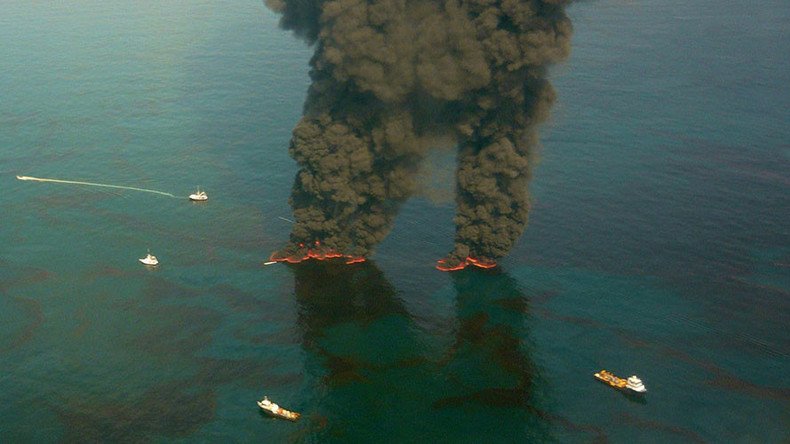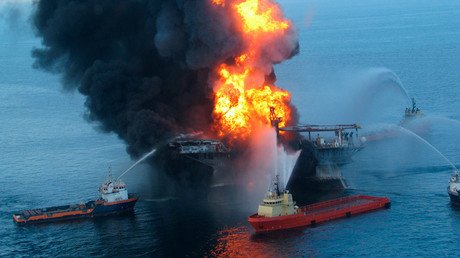BP oil spill caused $17.2bn worth of damage to natural resources – study

Scientists have estimated that the BP Deepwater Horizon oil spill caused $17.2 billion worth of damage in the first-ever natural resource survey. The survey results were calculated on how much the public were willing to pay for them in a one-time tax.
“This is proof that our natural resources have an immense monetary value to citizens of the United States who visit the Gulf and to those who simply care that this valuable resource is not damaged,” said Kevin Boyle, a professor of agricultural and applied economics in the Virginia Tech College of Agriculture and Life Sciences who was one of the authors of the paper.
First financial evaluation reveals the BP oil spill did an astonishing $17.2 billion in damage to natural resources https://t.co/7negKjnYn8pic.twitter.com/9C0JEavkWa
— GOOD (@good) April 21, 2017
One month after the oil spill in 2010, the US National Oceanic and Atmospheric Administration commissioned a group of 18 researchers to put a dollar value on the natural resources damaged by the BP Deepwater spill.
During large-scale accidents that causes damage to natural or cultural resources, government and industry can assess the value privately owned assets because of market transactions. More opaque is the value of natural assets that are not exchanged on the market, such as fishing or visiting a beach, or the value of those assets even when not used but which have value to the public.
The new survey seeks to remedy that challenge.
Economists put price to resources damaged in BP oil spill https://t.co/aPGYGmoksKpic.twitter.com/ROIptqFm4S
— Science (@scienmag) April 21, 2017
The survey interviewed a large random sample of American adults who were told about the state of the Gulf before the 2010 accident, what caused the accident, injuries to natural resources due to the spill, and a proposed program for preventing similar accidents in the future, and how much their household would a pay in extra taxes if the program was implemented.
The study also included face-to-face interviews. Respondents were also randomly separated in two groups that assessed the value for large injuries and smaller injuries.
Under small injuries the survey featured questions about the number of miles of oiled marshes, of dead birds, and of lost recreation trips. The larger set include the small injuries plus injuries to bottlenose dolphins, deep-water corals and young sea turtles.
In both sets, support for the program declined as the taxes increased, with the majority of respondents said they would support a tax increase of $15. When the spill caused a small number of injuries, a total of 52.2 percent said they would support a $15 tax and 43.5 percent a $65 tax. When the accident caused a larger number of injuries, 57.7 percent said they would support $15 tax, with 48.8 percent supporting a $65 tax.
Scientists concluded that an average household was willing to pay $153 for a prevention program.
“It is a credible way to thinking about it from an economic perspective. If you think about it, whenever someone makes a decision to go to a beach, it is not only to experience the beach but it is an economic decision. They decide how far they are going to travel, how much they are going to spend. When they make those decisions that reveals they have an economic value associated with it,” Professor Boyle told RT.
“People will travel further to get to a beach with higher quality. What we were doing was not only getting the values of people who visit it, but we were trying to get the value of who don’t visit the Gulf but do care about the resources of the Gulf. We created a choice situation in the survey that would allow them to express their values.”
The rate was multiplied by the number of households sampled to get the final evaluation at $17.2 billion.
“The results were eye-opening in that we could tell how much people really value marine resources and ecosystems,” Boyle said. “And even more meaningful because we did additional analysis that proved the legitimacy of oft-criticized values for environmental resources.”
Findings of the study, titled: “Putting a value on injuries to natural assets: The BP oil spill,” was published in the latest issue of the journal Science, which was published on April 20.
The BP Deepwater Horizon oil spill began on April 20, 2010, in the Gulf of Mexico on the BP-operated Macondo Prospect. Eleven people were killed and it is considered the largest accidental marine oil spill in the history of the petroleum industry. The US government estimated the total discharge at 4.9 million barrels (210 million US gallons; 780,000 m3).
BP estimates loss from Gulf of Mexico oil spill at almost $62bn https://t.co/xV6KypmzaVpic.twitter.com/cGIYaxQRo0
— RT (@RT_com) July 16, 2016
After several failed efforts to contain the flow, the well was eventually declared sealed on September 19, 2010, but reports in early 2012 indicated the well site was still leaking.
A massive response ensued to protect beaches, wetlands and estuaries from the spreading oil, utilizing skimmer ships, floating booms, controlled burns and 1.84 million US gallons (7,000 m3) of Corexit oil dispersant.
In November 2012, BP and the US Department of Justice settled federal criminal charges, with BP pleading guilty to 11 counts of manslaughter, two misdemeanors, and a felony count of lying to Congress. BP and the Department of Justice agreed to a record-setting $4.52 billion in fines and other payments. As of February 2013, criminal and civil settlements and payments to a trust fund had cost the company $42.2 billion.
In September 2014, a US District Court judge ruled that BP was primarily responsible for the oil spill because of its gross negligence and reckless conduct.
In July 2015, BP agreed to pay $18.7 billion in fines, the largest corporate settlement in US history.













